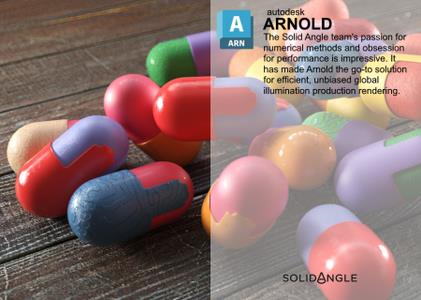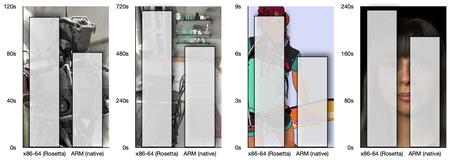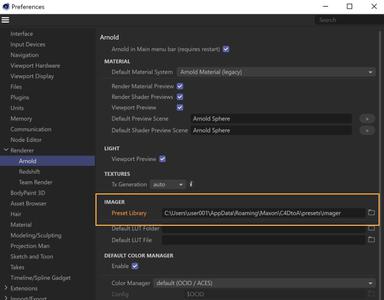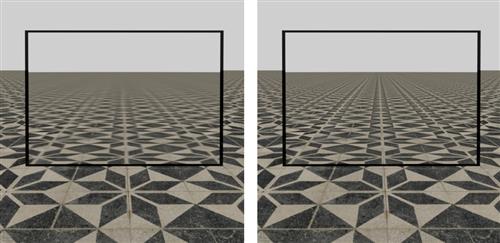
Solid Angle Cinema 4D to Arnold 4.5.0 | 5.1 Gb
Product:Solid Angle Cinema4D to Arnold
Version:4.5.0
Supported Architectures:x64
Website Home Page :www.arnoldrenderer.com
Languages Supported:english
System Requirements:Windows / macOs / Linux *
Size:5.1 Gb
The software developer Solid Angle announced the launch of Arnold (C4DtoA) 4.5.0 for Cinema4D. This update uses Arnold 7.1.4.0 and is a feature release bringing Apple native CPU support, imager presets, error reporting and other improvements and bug fixes.
4.5.0 - Date: 17 Nov 2022
-Apple Native CPU support:Arnold natively supports running under Apple M series CPUs, such as the M1 CPUs. Our tests give speedups of up to 1.45x compared to running with x86_64 Rosetta 2 translation (ARNOLD-10481, C4DTOA-2317)

-Imager presets:Presets of imager graphs and individual imagers can now be saved from the IPR window. Presets are stored in a selected preset library folder, which can be configured in the Preferences. Imager graph presets can be shared between Maya and Cinema 4D, support for other DCCs is planned in future releases. (C4DTOA-2175)


-Automatic generation of TX files:If Tx Generation mode is set to auto, Tx textures are now generated on demand, when the texture is first accessed during rendering, instead of generating all Tx files of the scene before the render starts. (C4DTOA-2842)
Note: First time running a render in existing scenes in C4DtoA 4.5.0, will re-generate all Tx files in 'auto' Tx mode.
-Hair melanin and redness:The standard_hair shader's melanin and melanin_redness parameters as well as the AidEonBSDF() function's absorption parameter are now being referenced in a linear sRGB color space so that the direct lighting results match when switching to other rendering color spaces such as ACEScg. The melanin_redness parameter will also now produce a more correct-looking red tint in ACEScg. (ARNOLD-7585).

-Sharp textures through reflections and refractions:Textures seen through specular reflections and refractions, particularly when there is low roughness, such as with clear windows and mirrors should now look correctly sharper. This can result in higher resolution texture mipmap levels being loaded in memory, so scenes that were affected by this can see an increase in texture cache usage. (ARNOLD-5632)

xSolid Angle Cinema 4D to Arnold 4.5.0

Close
-Crash reporting:When Arnold detects a crash in macOS, it will now open a dialog box asking if you want to report the crash to Autodesk. Submitting this will help us determine which crashes to prioritize fixing as well as aid us in deciphering why a crash occurred. If you provide your email address, when we determine that we have a fix for your crash, we will be able to notify you that a new version of Arnold is available with the fix. This is disabled in plugins in batch rendering and when kick -dw is used so that the dialog box doesn't hang a remote job on a render farm. Silent reporting can also be set, which causes Arnold to automatically report crashes to Autodesk without opening a crash window; this is done in kick by passing it the following argument: -er [email protected]. The environment variables ARNOLD_CER_ENABLED and ARNOLD_CER_AUTOSEND_EMAIL can also be used to control the error reporting. See the full documentation. (ARNOLD-10070)
Note: Crash reporting is not available on Windows yet.
-MaterialX 1.38.5:Arnold now ships with an updated MaterialX version, see the full release notes.(ARNOLD-12448)
-Autodesk Analytics Program:A newer version of the Autodesk Analytics Program (ADP) has been integrated into Arnold. This brings stability and performance improvements, including in situations where Arnold is used without internet access. If Arnold can identify the user with their Autodesk account, opt-in settings will automatically download from the internet, simplifying usage across multiple machines. Otherwise a one-time dialog window will appear if the computer does not have preexisting Analytics opt-in information. No dialog window will appear when running kick -dw, making it safe to use on headless render nodes. (ARNOLD-10787)
-Warn when adaptive sampling is enabled and there is no RGBA AOV:Adaptive sampling will only run on the RGBA (beauty) AOV. If there is no AOV with the name RGBA, then adaptive sampling is disabled. This can be particularly confusing when IPR has a display window and so adaptive sampling is used, but the batch render is done without display (kick -dw for instance) and adaptive sampling stopped working. We now emit a warning when this occurs so this issue can be easily detected. (ARNOLD-12521)
USD Enhancements
-USD 22.08The arnold USD procedural now use USD 22.08.
-MaterialX support:MaterialX shaders are now supported, both in Hydra and in the usd procedural. usd#1181

-Alembic support:Alembic references and payloads are now supported by the usd procedural. (ARNOLD-12593)
-Imager support:Imagers can now be rendered in Hydra and the procedural through an imager node graph connected to the RenderSettings "imager" attribute. usd#1305
-Skinning improvements:UsdSkel Skinning can now support instances and was made more efficient. Motion blur is now correct in both hydra and the procedural. usd#1291 usd#1078
-Support shader connections to mesh lights:It is now possible to connect shading graphs to a mesh light color. This can be done by connecting an ArnoldNodeGraph primitive to the mesh attribute primvars:arnold:light:shaders. usd#1294
-Skinning improvements:UsdSkel Skinning can now support instances and was made more efficient. Motion blur is now correct in both Hydra and the procedural. usd#1291 usd#1078
-Camera improvements:
. dataWindowNDC support has been improved for batch rendering. It now adds more pixels to the output image instead of simply adjusting the frustum, when using husk or kick. usd#1271
. The horizontal and vertical aperture offset attributes in the cameras are now supported, both in Hydra and in the procedural. This enables features such as render regions. usd#1225
-Cylinder lights:Cylinder lights are now supported in the usd procedural. usd#1231
-Render settings improvements:
. We can now set in the usd file which RenderSetting primitive will control the render by pointing the layer metadata attribute renderSettingsPrimPath to the RenderSetting primitive. usd#1235
. The aov_shader attribute of a RenderSettings primitive can now point to multiple ArnoldNodeGraph. They have to be separated by a space. usd#1321
. "Abort on error" is now declared as a Hydra render setting, and can be controlled in usd_view or mayaUSD. usd#1259
-RenderVar improvements:
. The attribute "arnold:filter" of the RenderVar primitive now defaults to box instead of closest_filter. usd#1313
. RenderVar aov name can be called "color" for the beauty, it was supported in the render delegate and is now supported in the procedural. usd#1311
-Improved default sampling values in Hydra:The default sample values were inconsistent between interactive Hydra versus batch rendering (e.g. with husk). This was improved, and now matches the other Arnold plugins. This is an incompatible change for scenes where sampling values were left to default. usd#1006
-Shader outputs registered in Sdr:The output attributes for Arnold shaders are now registered, along with their type, in the Sdr registry. This allows for applications / plugins to expose shading trees with Arnold shaders with the correct types. usd#1211
-Environment variable to debug Hydra:In order to help debugging Hydra renders, an environment variable HDARNOLD_DEBUG_SCENE can now be set to a .ass scene filename, allowing the Arnold scene data to be saved out as the render starts. usd#1266
Incompatible changes
-Hair melanin and redness in ACEScg:The changes to standard_hair shader's melanin and melanin_redness in ACEScg are potentially look-breaking. The absorption parameter for the AidEonBSDF() is now expected to be in a linear sRGB color space. Those changes can be reverted through the enable_deprecated_hair_absorption render option. (ARNOLD-7585)
-Autodesk Analytics Program:The following API should no longer be used as Arnold will now create the opt-in dialog window. In many cases they have been marked deprecated and will be removed in a major Arnold release. All these functions can be replaced by AiADPDisplayDialogWindow() and AiADPDisableDialogWindow() (ARNOLD-10787):
AI_API AI_DEPRECATED bool AiADPIntroWasShown();
AI_API AI_DEPRECATED void AiADPSetIntroShown();
AI_API AI_DEPRECATED void AiADPDialogStrings(AtParamValueMap&, const char*);
AI_API void AiADPSetOptedIn(bool wants_optin);
AI_API bool AiADPIsOptedIn();
-Autodesk network licensing:Autodesk Network License Manager (NLM) servers have to be updated to version 11.18, otherwise checking out a network license throws a Generic license checkout error (22).
Bug Fixes
- ARNOLD-12660 - Volume rendering performance regression in Arnold 7.1.3
- ARNOLD-11448 - Crash stacktrace is not always printed
- ARNOLD-12590 - [GPU] Single channel 8-bit textures are too bright
- ARNOLD-12675 - [Maketx] maketx tool doesn't recognize the -ignore-unassoc parameter
- ARNOLD-12619 - [MaterialX] Channel connections not exported when exporting MaterialX shading networks
- ARNOLD-12667 - [OCIO] Slow call to the OCIO color manager when reading raw textures in OSL
- usd#1278 Support visibility overrides on instances in the render delegate
- usd#1336 Fix empty ProductName rendering as .exr
- usd#1331 Fix motion blur sampling on skinned instances
- usd#1329 Fix inverted motion blur in the render delegate when using velocities
- usd#1315 Fix interpretation of primvars arrays with constant interpolation
- usd#1309 Fix RenderVar's filter width not translated properly in the procedural
- usd#1306 Allow to render deepexr RenderProduct with kick
- usd#1282 Don't set UsdUvTexture uvset when st coordinates are used
- usd#1281 Fix crash when a volume prim density field is invalid
- usd#1232 Set output to half precision for RenderVars with half types
- usd#1214 Make Sdr node discovery results consistent across renderers
Arnoldis an advanced cross-platform rendering library, or API, developed by Solid Angle and used by a number of prominent organizations in film, television and animation, including Sony Pictures Imageworks. It was developed as a photo-realistic, physically-based ray tracing alternative to traditional scanline based rendering software for CG animation.
Arnold uses cutting-edge algorithms that make the most effective use of your computer's hardware resources: memory, disk space, multiple processor cores, and SIMD/SSE units.
The Arnold architecture was designed to easily adapt to existing pipelines. It is built on top of a pluggable node system; users can extend and customize the system by writing new shaders, cameras, filters and output driver nodes, as well as procedural geometry, custom ray types and user-defined geometric data. The primary goal of the Arnold architecture is to provide a complete solution as a primary renderer for animation and visual effects.
Arnold renderer
Arnold for Cinema4D (C4DtoA)supports most Cinema 4D features such as instances, cloners, deformers, generators, MoGraph geometry, hair, and ThinkingParticles. It also supports both animation and single frame distributed rendering in Team Render, allowing the use of all computers in a local network to speed-up Arnold rendering. Third-party plugins TurbulenceFD and X-Particles are natively supported, allowing artists to render high quality smoke, fire, and particle effects with fully interactive feedback. Other features include volume rendering with OpenVDB, a node-based material editor and a comprehensive list of shaders and utilities, including vertex maps and per-face materials.
HOW TO Realistic Shaders in Cinema 4d and Arnold | Plastic, Wood, Concrete and Metal | Tutorial
Solid Angle SLis the technology company behind the Arnold rendering software, with offices in Madrid and London and customers throughout the world including Framestore, DreamWorks, ILM, Sony Pictures Imageworks, MPC, The Mill, Mikros Image and Rising Sun Pictures. Arnold was designed from the ground up to efficiently raytrace the complex geometric datasets required for feature-length CGI animation and big budget visual effects, while at the same time simplifying the pipeline, reducing the number of passes, minimizing storage requirements and greatly enhancing interactivity for lighting artists.
 Views: 9
Views: 9  Comments (0)
Comments (0)
free Solid Angle Cinema 4D to Arnold 4.5.0 Win x64, Downloads Solid Angle Cinema 4D to Arnold 4.5.0 Win x64, RapidShare Solid Angle Cinema 4D to Arnold 4.5.0 Win x64, Megaupload Solid Angle Cinema 4D to Arnold 4.5.0 Win x64, Mediafire Solid Angle Cinema 4D to Arnold 4.5.0 Win x64, DepositFiles Solid Angle Cinema 4D to Arnold 4.5.0 Win x64, HotFile Solid Angle Cinema 4D to Arnold 4.5.0 Win x64, Uploading Solid Angle Cinema 4D to Arnold 4.5.0 Win x64, Easy-Share Solid Angle Cinema 4D to Arnold 4.5.0 Win x64, FileFactory Solid Angle Cinema 4D to Arnold 4.5.0 Win x64, Vip-File Solid Angle Cinema 4D to Arnold 4.5.0 Win x64, Shared Solid Angle Cinema 4D to Arnold 4.5.0 Win x64, Please feel free to post your Solid Angle Cinema 4D to Arnold 4.5.0 Win x64 Download, Movie, Game, Software, Mp3, video, subtitle, sample, torrent, NFO, Crack, uploaded, putlocker, Rapidgator, mediafire, Netload, Zippyshare, Extabit, 4shared, Serial, keygen, Watch online, requirements or whatever-related comments here.
Related Downloads :
{related-news}





